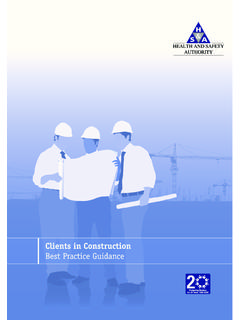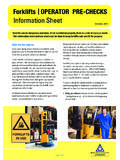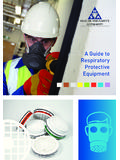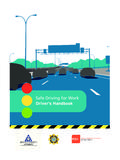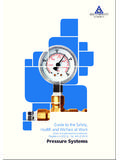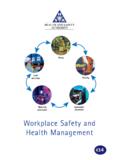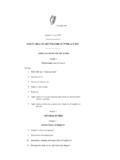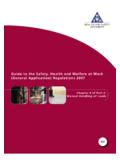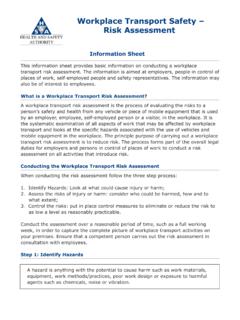Transcription of Accident and Dangerous Occurrences Reporting
1 Guidance on the Safety, Health and Welfare at Work( Reporting of Accidents and Dangerous Occurrences )Regulations 2016 Updated October 2016 Guidance on the Safety, Health and Welfare at Work ( Reporting of Accidents and Dangerous Occurrences ) Regulations 2016 Our Vision:healthy, safe and productive lives1. Introduction 22. Why is Accident and Dangerous occurrence Reporting required? 23. What accidents and personal injuries are reportable? 24. What Dangerous Occurrences are reportable? 45. Who is responsible for Reporting ? 46. Reporting requirements employers 57. Reporting requirements self-employed and landlords/tenants 68. Preserving the scene of a fatal Accident 79. When and how reports should be made 710. Requirement to keep records 7 Appendix 1 8 Published by the Health and Safety Authority, The Metropolitan Building, James Joyce Street, Dublin 1. All rights 2 Guidance on the Safety, Health and Welfare at Work ( Reporting of Accidents and Dangerous Occurrences ) Regulations 20161.
2 IntroductionThis guide is to assist you to understand the requirements set out in the Safety, Health and Welfare at Work ( Reporting of Accidents and Dangerous Occurrences ) Regulations 2016 ( No. 370 of 2016). It explains why Accident and Dangerous occurrence Reporting is required, what is reportable, what is not reportable, who should make the report and how the report should be made. This document is not intended as a legal interpretation of the legislation. The new regulations do not override existing statutory requirements; Reporting requirements set out in other legislation must continue to be complied following outlines the key points in relation to Reporting of accidents and Dangerous Occurrences : - Only fatal and non-fatal injuries are reportable. Diseases, occupational illnesses or any impairments of mental condition are not reportable. - Fatal accidents must be reported immediately to the Authority or Garda.
3 Subsequently, the formal report should be submitted to the Authority within five working days of the death. - Non-fatal accidents or Dangerous Occurrences should be reported to the Authority within ten working days of the event. - The injury of any employee as a result of an Accident while at work where the injury results in the employee being unable to carry out their normal work duties for more than three consecutive days, excluding the day of the Accident , must be Why is Accident and Dangerous occurrence Reporting required?Developing successful prevention policies requires an understanding of the prevalence and trends of certain Accident types, and such understanding is based on up-to-date and reliable information. The Accident and Dangerous occurrence reports provide the Authority with data that assists in targeting activities and advising employers on preventing injuries and accidental loss.
4 A small proportion of the more serious accidents are investigated by our What accidents and personal injuries are reportable? An Accident is an unplanned event resulting in death, or resulting in an injury such as a severe sprain or strain (for example, manual handling injuries ), a laceration, a broken bone, concussion or unconsciousness. Page 3 Cyan 100%Magenta 76%Y ellow 0 Black 27%The Safety, Health and Welfare at Work Act 2005 contains the following definitions: Accident means an Accident arising out of or in the course of employment which, in the case of a person carrying out work, results in personal injury. personal injury includes (a) any injury, disease , disability, occupational illness or any impairment of physical or mental condition, and (b) any death, that is attributable to the purposes of these Regulations only fatal and non-fatal injuries are reportable. Diseases, occupational illnesses or any impairments of mental condition are not reportable.
5 Note that directly caused mental injuries such as shock or fright as the result of an assault, continue to be reportable. Information on work-related diseases and illnesses is available from a range of other sources, such as survey data collected by the Central Statistics Office, claims data collected by the Department of Social Protection, and agencies that collect health statistics and insurance claims are three situations in which an Accident should be reported: (a) arising in the course of employment resulting in personal injury to the person carrying out the work activity. This could be an injury to an employee who is actually doing the work. For example: an employee dislocates a shoulder while manually moving a heavy load or an employee dealing with the public is assaulted.(b) arising in the course of employment which results in personal injury to an employee who was not doing the work that is the subject of the Accident .
6 For example: a shelving system collapses and injures an employee who is passing by the scene at the time of the collapse.(c) arising from a work activity which results in personal injury to a person outside of the course of employment. This could be an injury to a non-employee or member of the public. For example: a load falls from a truck that is being used for work purposes, and causes an injury to a member of the public who is not at of incidents that are not reportable include those where: - an employee or a self-employed person is absent as a result of an Accident for more than three days, but the absent days are not consecutive. - an employee is injured in a traffic collision while commuting to or from a patient of a registered medical practitioner dies, is injured or suffers ill health while undergoing medical treatment, unless the treatment is being carried out as a result of a workplace incident. Medical treatment includes treatment such as the administration of medicines by any route, surgical procedures or dressing of wounds.
7 Page 4 Guidance on the Safety, Health and Welfare at Work ( Reporting of Accidents and Dangerous Occurrences ) Regulations 2016 However, patient care that is part of everyday patient management is not considered medical treatment and, in these cases, an incident may be reportable. For example, patient handling that includes the moving of patients, whether in bed or from place to place, is not considered medical treatment. Cleaning and bathing are other examples of patient care that are not considered medical treatment. 4. What Dangerous Occurrences are reportable?The Safety, Health and Welfare at Work Act 2005 contains the following definition: Dangerous occurrence means an occurrence arising from work activities in a place of work that causes or results in (a) the collapse, overturning, failure, explosion, bursting, electrical short circuit discharge or overload, or malfunction of any work equipment, (b) the collapse or partial collapse of any building or structure under construction or in use as a place of work, (c) the uncontrolled or accidental release, the escape or the ignition of any substance, (d) a fire involving any substance, or (e) any unintentional ignition or explosion of explosives, as may be prescribed Dangerous Occurrences which must be reported to the Authority are listed in Appendix Who is responsible for Reporting ?
8 Employers, self-employed, landlords, owners and tenants all have a duty to report accidents and Dangerous Occurrences to the 5 Cyan 100%Magenta 76%Y ellow 0 Black 27%6. Reporting requirements employersFatal accidents in a workplace should be reported immediately to the Authority or the Garda so that the necessary action, including any investigation by the Authority, can take place. Subsequently, the formal Accident report form should be submitted to the Authority within five working days of the death. Non-fatal accidents or Dangerous Occurrences should be formally reported within 10 working days of the event. Firstly, in relation to your employees: You must report the death of an employee if this is as a result of an Accident at work. The Accident may have taken place either at your place of work or at another employer s place of work, or in a location other than the normal place of work. The following are examples of reportable fatalities: - Your employee is fatally injured as a result of being hit by a delivery truck in your yard.
9 - Your employee is fatally injured while driving for work on a public road. - Your employee is fatally injured while carrying out contract work for another employer at their You must report the injury of any employee as a result of an Accident while at work where the injury results in your employee being unable to carry out their normal work for more than three consecutive days, excluding the day of the Accident . In calculating the days, you should include weekends and other non-working days. The following are examples of reportable accidents: - An employee, which includes a trainee, who normally has Saturday and Sunday off work, is injured on Wednesday and returns to work the following Monday. - A driver or a passenger is involved in a road traffic Accident while driving or riding in the vehicle in the course of work and he is out of work for more than three days. - An employee, while lifting boxes on Monday, hurts her back.
10 She returns to work on Thursday but she can only do light duties for the next week. Even though she was not absent for more than three days, she could not perform her normal work for more than three You must report any case where an employee dies as a result of an Accident at work within one year of that Accident , even if you had already reported the Accident . Page 6 Guidance on the Safety, Health and Welfare at Work ( Reporting of Accidents and Dangerous Occurrences ) Regulations 2016 Secondly, in relation to non-employees (non-workers, members of the public, employees of another enterprise) at your place of work: You must report the death of a person who is not your employee and who is not at work, but who dies from an Accident caused by a work activity at the place of work. For example, if you are responsible for road works and a member of the public is injured by a reversing vehicle in the course of the work, and subsequently dies as a result of their injuries , then you must report that You must report the injury of a person who is not your employee and who is not at work but who is injured from a work activity if the injured person has had to be taken from the location of the Accident to receive treatment in respect of that injury in a hospital or medical facility.
